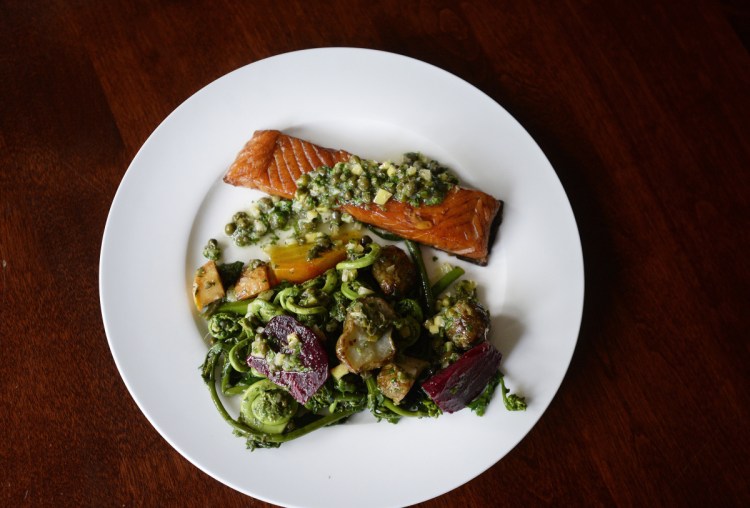I typically eat plenty of vegetables, thanks both to Mom’s early training on how to divide your dinner plate and to Weight Watchers deeming most green things devoid of points. But come late winter and early spring, I tend to fall off the vegetable wagon. By that point, I’m sick of root vegetables, I’ve eaten so much local hot-house lettuce that I feel like a rabbit, and I just can’t pull the trigger on asparagus from Peru or broccoli from California even if I have to impatiently wait for those lovelies to show up at the farmers market here.
So when they finally do, I overdo it. The first couple of shopping days when local asparagus, broccoli and kale rabe, fresh peas, and foraged fiddleheads and nettles make it into my kitchen, I scarf them up, no problem. But then the weeks wear on and I slough off on the daily vegetable prep, promising the green eating gods that I’ll cook the remainder of my farmers market haul another day. When that day doesn’t come, I’ve got wasted food on my hands.
So I’ve taken to blanching all the fresh green vegetables that come home with me as soon as I walk in the door. I’ve already sunk the time, effort and money into finding these vegetables so it makes economic and environmental sense to shop, chop, drop and boil. Once I shock lightly boiled green vegetables in icy water and lay them on a towel to dry, I’ve got my vegetables prepped and almost ready for use in pasta sauces, clean-the-fridge frittatas, sautéed side dishes, interesting pizza toppings and anchoring salad ingredients.
An early chapter in food writer Tamar Adler’s book “An Everlasting Meal, Cooking with Economy and Grace,” is devoted to how much a pot of boiling water can do for a cook. She waxes eloquently on how the invention of the pot 10,000 years ago enabled this cooking process and presses modern, busy cooks to harness its power. “While you’ve got a pot of water boiling and are standing near it, let it do you proud.” That is, don’t waste the energy is takes to bring that pot of water to boil for just one bunch of asparagus. Drop all sorts of green vegetables into the pot sequentially, starting with those with mild, sweet flavor like peas and progressing to ones with stronger, bitter flavors like broccoli rabe.

Christine Burns Rudalevige cooks asparagus for Hot Smoked Salmon and Vegetable Plate with Preserved Lemons and Caper Vinaigrette well ahead of time.
Adler also espouses cooking vegetables as close to buying them as possible. If that can’t be immediately, she advises throwing them all in a large bowl of water in the sink. Having them in plain sight, as opposed to in the crisper in the refrigerator, makes it harder to ignore the task.
Food scientist Harold McGee offers precise advice on how to process your bright, green vegetables for near future use. In his book, “Keys to Good Cooking: A Guide to Making the Best Foods and Recipes,” McGee says that boiling cooks green vegetables quickly to preserve both Vitamin C content and the bright green color of chlorophyll. The disadvantage is the potential loss of nutrients leached out of the vegetables. To help stem the leaching, don’t cut your green vegetables too finely as cut surfaces release more flavor and nutrients into the water.
He advises using plenty of water – 6 quarts for every 2 pounds of vegetables you’ll be cooking at once. Adding 4 tablespoons of kosher salt per quart will further reduce the leaching. Bringing the water to a hard boil before adding the vegetables and getting it back to the boil after adding them, a process greatly sped up through the use of a lid, inactivates damaging enzymes that will otherwise turn your vegetables mushy. No green vegetable will need to be boiled more than 10 minutes, but check them often and remove them as soon as they are crisp-tender. Chemically speaking, green vegetables stay green longer in neutral or alkaline water. So if yours turn dull after five minutes of cooking, add a pinch of baking soda to the pot.
Transfer these blanched vegetables to ice water to help set the bright green color. Once they are cooled, spread them on a towel to dry before placing them in airtight containers to sit in the refrigerator until you need them. You can skip the ice-water step, called “shocking” in kitchen lingo, says McGee. But if you do, toss the drained, still warmed vegetables in just enough olive oil to coat or risk the skins wrinkling as they release steam.
Blanching green vegetables well ahead of when you plan to use them is not rocket science, for sure. But it certainly makes good sense in a green kitchen.
ABOUT THE WRITER
CHRISTINE BURNS RUDALEVIGE is a food writer, recipe developer and tester, and cooking teacher in Brunswick, and the author of “Green Plate Special,” a cookbook from Islandport based on these columns. She can be contacted at cburns1227@gmail.com.
Send questions/comments to the editors.



Success. Please wait for the page to reload. If the page does not reload within 5 seconds, please refresh the page.
Enter your email and password to access comments.
Hi, to comment on stories you must . This profile is in addition to your subscription and website login.
Already have a commenting profile? .
Invalid username/password.
Please check your email to confirm and complete your registration.
Only subscribers are eligible to post comments. Please subscribe or login first for digital access. Here’s why.
Use the form below to reset your password. When you've submitted your account email, we will send an email with a reset code.